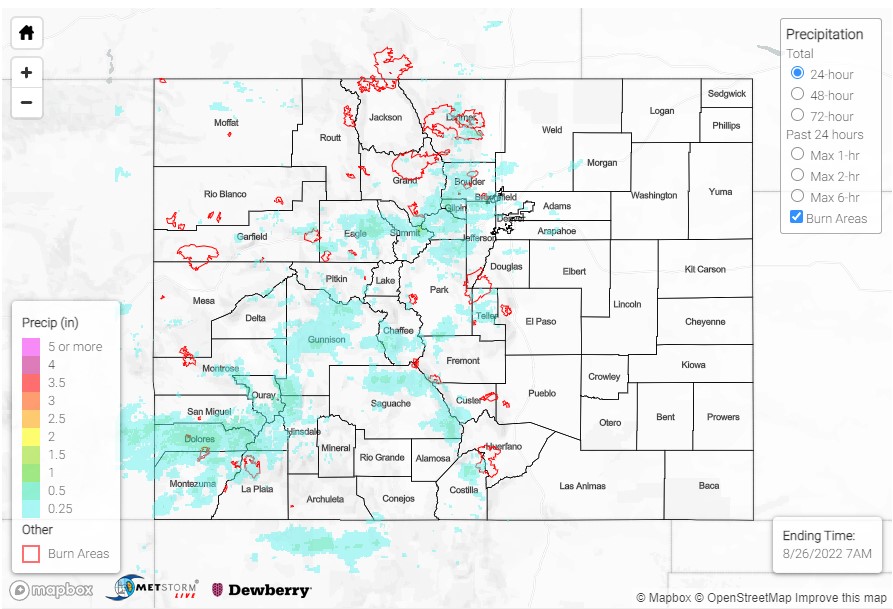Issue Date: Friday, August 26th, 2022
Issue Time: 10:30 AM MDT
Summary:
Precipitation across Colorado was largely constrained to the western half of the state yesterday. The Southwest Slope to Central Mountains continued to benefit from monsoonal moisture circulating the high-pressure system centered over the Colorado-New Mexico border. Early morning cloud coverage over much of the region limited some heavy rainfall potential, though cloud-free areas, especially in the higher terrain, saw more intense convection. Gusty outflows from afternoon storms also resulted in non-thunderstorm wind gusts of 46 and 45 mph in Craig and Montrose, respectively. For the Northern Mountains, a shortwave dipping south into the state from Wyoming helped provide the necessary ingredients for showers and thunderstorms there, spilling onto the Front Range and Urban Corridor as the day progressed. The Eastern Plains remained largely dry yesterday.
Only a few flood advisories and a flash flood warning for Larimer county were issued yesterday, which included portions of the Cameron Peak burn scar. Several automated gages reported up to 0.28-0.31 inches over the scar, though thankfully no flooding was reported so far.
As of this morning, CDOT has reported debris on US550 in two locations from Ouray to Silverton, both causing brief closures. Gauge observations nearby are sparse, but QPE from MetStorm live puts up to 0.50 inches over the area and a MesoWest gauge west of Ouray reported 0.87 inches yesterday.
Some other notable high precipitation totals (in inches) across Colorado include:
- 1.14 in Crestone
- 0.91 near Hesperus
- 0.82 at Long Hollow Reservoir (and between 0.40- 0.70 elsewhere in Montezuma and La Plata Counties on the Southwest Slope)
- 0.77 in Vail
- 0.73 in Divide, along with brief graupel
- 0.61 near Pagosa Springs
- 0.59 in Nederland
Precipitation totals were more modest along the Front Range and western edge of the Urban Corridor, but up to 0.51 was reported from a MHFD gauge near Hidden Lake northwest of Boulder.
Some other important news – beginning yesterday, Denver’s radar went down for service, lasting approximately the next week. See the tweet below from the Boulder WFO explaining the service upgrade and radar coverage without Denver online. While the Denver radar has greater coverage from adjacent stations when down, especially compared to Grand Junction and Pueblo, QPE in the region will still likely be underestimated during the week of the outage.
📣Denver Radar Outage:📣
Starting tomorrow morning, August 25th, the Denver radar will be down for service. This service upgrade is critical to extending the radar’s life into the 2030s. There are plenty of nearby radars that will provide coverage in its absence. #COwx pic.twitter.com/6GE82hP0zK
— NWS Boulder (@NWSBoulder) August 24, 2022
If you observe flooding in your area, remember to use the “Report a Flood” page to make any flood reports when you can safely do so. For precipitation estimates in our area, check out the map below.
